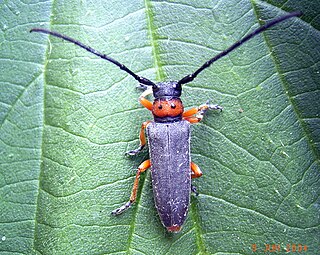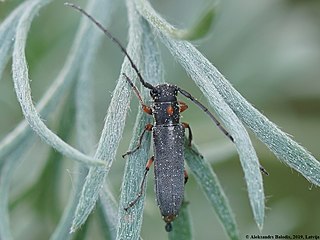
Glycyrrhiza is a genus of about 20 accepted species in the legume family (Fabaceae), with a subcosmopolitan distribution in Asia, Australia, Europe, and the Americas.

Iris bucharica is a species of flowering plant in the family Iridaceae. It is a bulbous herbaceous perennial, from temperate Asia, within Afghanistan, Tajikistan and Uzbekistan. It has long blue green leaves, many flowers in spring, in shades of yellow and white.

Phytoecia is a genus of longhorn beetles of the subfamily Lamiinae,
Phytoecia gianassoi is a species of beetle in the family Cerambycidae. It was described by Sama in 2007 and later reclassified to the subgenus Coptosia within the genus Phytoecia.
Phytoecia paulusi is a species of beetle in the family Cerambycidae. It was described by Holzschuh in 1971.

Phytoecia puncticollis is a species of beetle in the family Cerambycidae. It was described by Faldermann in 1837. It is known from Russia, Azerbaijan, Georgia, Iraq, Armenia, Turkey, Iran, and Turkmenistan. It feeds on Eryngium billardierei.
Phytoecia gaubilii is a species of beetle in the family Cerambycidae. It was described by Mulsant in 1851. It is known from Tunisia and Algeria.

Phytoecia comes is a species of beetle in the family Cerambycidae. It was described by Henry Walter Bates in 1884. It is known from Taiwan, Myanmar, North Korea, South Korea, China, Vietnam, and Japan.
Phytoecia humeralis is a species of beetle in the family Cerambycidae. It was described by Waltl in 1838, originally under the genus Saperda. It is known from Palestine, Greece, Georgia, Iran, Azerbaijan, Syria, Cyprus, and Turkey. It feeds on Silybum marianum.
Phytoecia millefolii is a species of beetle in the family Cerambycidae. It was described by Adams in 1817, originally under the genus Saperda. It has a wide distribution between Europe and the Middle East.
Phytoecia praetextata is a species of beetle in the family Cerambycidae. It was described by Steven in 1817, originally under the genus Saperda. It is known from Turkey, Bulgaria, Syria, Armenia, Romania, and Ukraine.

Phytoecia affinis is a species of beetle in the family Cerambycidae. It was described by Harrer in 1784, originally under the genus Leptura. It has a wide distribution in Europe.

Phytoecia caerulescens is a species of beetle in the family Cerambycidae. It was described by Scopoli in 1763, originally under the genus Leptura. It has a wide distribution in Europe, and has been introduced into Australia. It feeds on Echium vulgare, Lappula squarrosa, Anchusa officinalis, Lithospermum officinale, and Cynoglossum officinale.

Phytoecia caerulea is a species of beetle in the family Cerambycidae. It was described by Scopoli in 1772, originally under the genus Leptura. It has a wide distribution in Europe.

Phytoecia icterica is a species of beetle in the family Cerambycidae. It was described by Schaller in 1783, originally under the genus Saperda. It has a wide distribution between Europe and the Middle East. It feeds on Daucus carota sativus, Petroselinum crispum, Pastinaca sativa sativa, Pastinaca sativa, Conium maculatum, and Pimpinella saxifraga.

Phytoecia pustulata is a species of beetle in the family Cerambycidae. It was described by Schrank in 1776, originally under the genus Cerambyx. It has a wide distribution throughout Europe and the Middle East.

Phytoecia rufiventris is a species of beetle in the family Cerambycidae. It was described by Gautier des Cottes in 1870. It is known from Russia, Japan, Taiwan, Mongolia, North Korea, South Korea, China, and Vietnam. It feeds on Artemisia vulgaris.
Phytoecia tenuilinea is a species of beetle in the family Cerambycidae. It was described by Léon Fairmaire in 1877. It is known from Morocco and Algeria.
Phytoecia hirsutula is a species of beetle in the family Cerambycidae. It was described by Frölich in 1793, originally under the genus Saperda. It has a wide distribution between Europe and the Middle East.

Prunus bucharica is a species of wild almond native to Tajikistan, Uzbekistan and Afghanistan, preferring to grow at 1000-1800 m above sea level. Long thought to be one of the wild species that contributed to the origin of the cultivated almond, genetic testing of both nuclear and chloroplast DNA has shown that to be untrue; the closest relative of Prunus dulcis is Prunus fenzliana.











